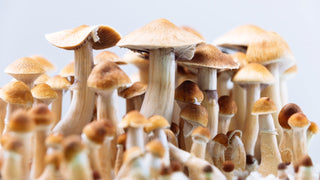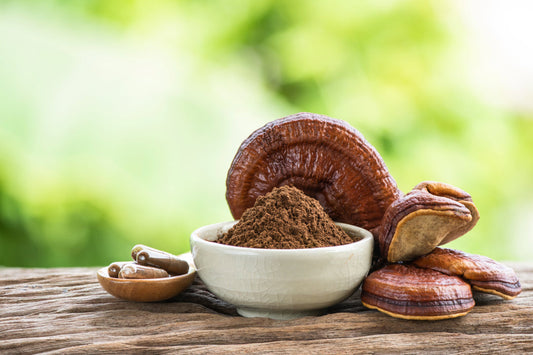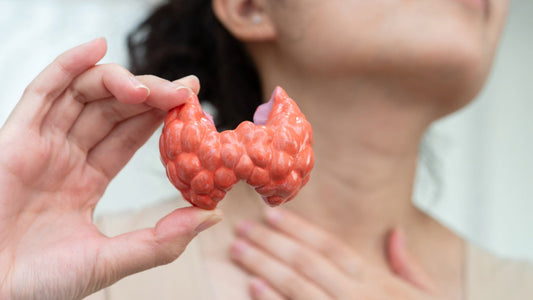Psychedelic mushrooms (most often Psilocybe species) contain psilocybin, a compound that the body rapidly converts to psilocin, which produces the psychedelic effects the mushroom is famous for. But psilocin takes time to clear from the body, creating concern for duration of effects or detectability on drug tests.
How long mushrooms' psychedelic compounds “stay in your system” depends on what you mean: the time you feel effects, how long psilocin is measurable in blood or urine, and how long specialized tests might detect use. We're covering them all in this article: Our evidence-based overview of how long shrooms stay in your body. Let's get to it!
Key Takeaways
- Onset and duration: Hallucinogenic effects ("normal dose" range, as opposed to microdosing) usually begin in 20-60 minutes, peak around 2-3 hours, and resolve in a few hours (4-6, sometimes up to 8).
- Several factors affect onset and duration, including dose, potency, stomach contents, body mass, and individual metabolism and tolerance of a person's system.
- Half-life: Shroom half-life is roughly 1.5-4 hours in humans; levels of the active metabolite psilocin typically fall to low/undetectable by 24 hours.
- Detection in urine: Specialized tests can detect psilocin for roughly a day after ingestion; routine workplace panels generally do not screen for psilocybin/psilocin.
- Detection in blood/oral fluid: Psilocin is measurable in plasma for several hours after dosing and can be detected in oral fluid with targeted methods, but practical windows are short (about 24 h) and testing is uncommon.
- Detection in hair: Hair testing can reveal prior use weeks to months later with sensitive assays, though it’s rarely requested.
- Dose matters: Higher doses prolong and intensify effects and can extend detectability within the first 24 hours; tea (faster absorption) vs. whole dried mushrooms can shift timing slightly.
- Amanita muscaria (Fly Agaric): This is another lesser-known psychedelic mushroom that clears from the body quickly, from a few hours to about a day. Fly agaric is not considered safe. It has unpredictable effects and should be avoided.
Disclaimer
This content is for educational purposes only and is not medical, legal, or employment advice. Psilocybin mushrooms (commonly referred to as "magic mushrooms") are illegal in many jurisdictions. Detection windows vary widely by dose, metabolism, and the specific laboratory assay, and employer policies differ -- do not use this information to time or evade drug tests. Never drive or perform safety-sensitive tasks while impaired. Consult a licensed clinician for health questions and an attorney or HR representative for policy questions. Psilocybin mushrooms are not for everyone; only consider them after talking to your doctor. If you have mental health issues or other concerns about mental well-being, it is especially important to take psilocybin under the supervision of a healthcare professional; ideally, a therapist. While the psychedelic compound in psilocybin has some accepted medical use for mental health conditions, it is a powerful experience that should be monitored carefully as a best practice for safety and beneficial potential.
Why Psychedelic Mushrooms?

Psychedelic mushrooms are a class of functional mushrooms with potential beneficial health effects, especially in the context of mental wellness. Mushrooms' psychoactive compounds include psilocybin: a compound your body converts to psilocin, which is associated with altered perception, mood, and cognition.
People use them for many reasons: clinical research on depression and anxiety, full-dose therapeutic sessions aimed at insight and emotional reset, and “microdosing” in search of subtle boosts to mood or focus. Discover research-backed microdosing benefits
Psilocybin mushroom species are typically from the genus Psilocybe. Taking shrooms frequently can lead to tolerance. Shroom addiction and withdrawal symptoms are rare (see the science here), however; some experts suggest psychological dependence may be possible. Shroom use within a microdosing protocol is better tolerated, even subperceptual (you don't feel a thing!)
Check out our Educational Article on How to Microdose Mushrooms
Next up, we outline how long shrooms stay in your system, what that means for detection windows in blood, urine, saliva, and hair. We'll also touch upon how fast psilocybin takes effect, how long those effects last, and briefly cover Fly Agaric -- although that psychedelic mushroom is not advisable to take due to its potential toxicity risks.
From Ingestion to “Afterglow”: What to Expect Over Time
Here’s the high-level arc on how long mushrooms stay in your body, before we dive into details. After ingesting psilocybin, your body converts it to psilocin.
Subtle shifts often begin within 20-60 minutes (faster with tea/empty stomach), build to a peak about three hours in, then taper over roughly 4-6 hours (sometimes up to 8), with many people describing a gentle, non-intoxicating “afterglow” afterward.
“Set and setting” are a key component of a successful psilocybin experience.
This is a phrase referring to your internal mindset (mood, expectations, intentions, mental health) and the external environment (physical space, people, music, and safety) that together shape how a psychedelic experience unfolds. Good set and setting can support a positive experience and reduce risk of a "bad trip."
The exact timeline is shaped by dose and potency of psilocybin mushroom species, recent food, individual metabolism, and -- crucially -- set and setting.
Microdoses tend to feel shorter and sub-perceptual; users may feel subtle cognitive enhancements, not unlike today's best nootropic supplements.
Full therapeutic doses of psilocybin, on the other hand, are immersive and day-altering. The timeline below maps these phases so you know what to expect before, during, and after a session.
- 0-60 minutes: Onset. If taken on an empty stomach (or as tea), onset tends to be faster. Early signs include shifts in sensory function and mood.
- 2-3 hours: Peak effects. Perceptual, emotional and psychological effects are most intense.(1) Visual hallucinations, time shifts, and other psychedelic experiences may occur. Dilated pupils, rapid breathing, slightly faster heart rate, tremor, muscle weakness and other physical effects may be noticed.
- 4-6 (up to 8) hours: Tapering effects. Most acute effects fade as the body's natural detox process takes over and starts clearing plasma psilocin.
- Later that day/next day: Many users report a mild, non-intoxicating “afterglow” (clearer mood, residual calm), even after levels are low or nonexistent.
Did you know?
Functional mushroom expert Paul Stamets suggests stacking psilocybin microdoses with Lion's Mane Mushroom for its nerve growth factor (NGF) benefits and Niacin (Vitamin B3) for its "flushing" effects that help encourage circulation and distribution of psilocyn.
What Determines How Long Psilocybin Stays Detectable?
- Metabolism and excretion: Psilocybin is quickly converted to psilocin, which is metabolized and excreted -- primarily in urine -- within about a day.
- Dose and formulation: Larger doses yield higher and longer psilocin exposure; tea tends to shorten onset but not necessarily the total duration.(2)
- Individual biology: Individual absorption and metabolism varies, contributing to differences in timing and intensity of effects.
- Tolerance (not detectability): Classic psychedelics show rapid, short-term tolerance for several days after use; this affects effects more than lab detectability.
Employers, Drug Tests, and Psilocybin

If you're reading this article because you are worried about drug testing for magic mushrooms, fear not. Most U.S. workplace drug programs -- especially those tied to federal rules -- do not include psilocybin in their standard screening panels.
Federal “5-panel” routine drug tests cover marijuana/THC, cocaine, amphetamines (incl. MDMA/MDA), opioids (incl. several semi-synthetics), PCP and other substances; psilocybin/psilocin isn’t on that list. Safety-sensitive jobs regulated by the U.S. Department of Transportation follow the same five drug classes.
- Expanded or specialty tests: While uncommon, an employer or court can order specialty assays that specifically detect psilocybin or psilocin; routine 5- or 10-panel screens typically won’t detect them.
- Short detection window: Psilocybin is rapidly metabolized (to psilocin) and cleared within a short time frame, which also makes standardized workplace tests to detect drug use less common for mushrooms; specialty testing is usually required and must be timed closely.
- Policy still rules: Even in places that have decriminalized or piloted therapeutic access, employers may maintain zero-tolerance or “no on-duty impairment” policies -- especially in safety-sensitive roles. Federal law still classifies psilocybin as illegal, and employer policies can prohibit its use.
- Know your handbook: If employment is subject to federal testing (e.g., DOT) or if your workplace uses expanded panels beyond standard drug tests, expectations and consequences are laid out in company policy and applicable regulations.
Key takeaway: Standard employer tests screen for addictive substances. They don’t typically detect magic mushroom use, but specialty testing exists, and workplace rules -- not local decriminalization -- ultimately govern what’s allowed. When in doubt, check your employer’s written policy and any role-specific regulations.
Urine Tests
Psilocin is the primary urinary analyte; much of it is excreted as a glucuronide conjugate. Studies show free psilocin is generally detectable for many hours and can remain detectable up to 24 hours.(3) Beyond a day, detection likelihood falls quickly.
Blood Tests
Plasma psilocin rises with maximum levels around 2-3 hours and then declines with a 1.5-4 hour half-life; practical windows to detect shrooms consumption are typically limited to the same day.
Oral Fluid (Saliva Tests)
Validated methods can measure psilocin in oral fluid after consuming shrooms, but clinical detection windows appear short (hours) and oral-fluid testing for psilocybin is uncommon outside research/forensics.
Hair
Psilocin from magic mushrooms can be incorporated into hair and detected weeks to months later with sensitive methods.(4) Hair follicle tests for psilocybin use is possible but rarely ordered.
Workplace Panels
The standard federally referenced “SAMHSA-5” focuses on cannabinoids (THC), cocaine, amphetamines, opioids, and PCP; psilocybin is not among these default classes.(5) Employers can request expanded panels, but that is atypical.
Does Dose Change How Long You Feel It?
Yes. Higher doses (e.g., moderate to high “session” doses used in clinical trials) intensify and may modestly lengthen the experience compared with very low or “micro” doses. Fixed-dose studies (15–30 mg psilocybin) show dose-proportional increases in plasma psilocin and subjective effects, with most acute effects still resolving the same day.
Quick Reference Recap
- Onset: 20-60 min. Faster with tea/empty stomach.
- Peak: About 2-3 h. Aligns with plasma psilocin peak in blood.
- Duration (acute effects): 4-6 (to 8) hours; varies with dose and individual factors.
- Psilocin half-life: About 1.5-4 hours. Human PK studies and systematic reviews.
- Urine detectability: Up to about 24 hours.
- Blood/oral fluid detectability: Hours (clears same day)
- Hair detectability: Weeks to months.
Amanita Muscaria (Fly Agaric)

Amanita muscaria’s main active compounds are muscimol and ibotenic acid. Their effects typically start in 30-120 minutes, peak around 2-3 hours, and fade within 6-8 hours. Lingering effects may include grogginess or vivid dreams into the next day. Both compounds are cleared rapidly -- largely via urine -- so the detection window is short (often just a few hours, a day tops).
Standard workplace drug panels don’t test for these mushrooms, although some specialized assays can. Potency is unpredictable and toxicity is a concern. Fly Agaric isn’t recognized as safe for food use, so caution -- and medical attention for concerning symptoms -- is essential. Better still, just avoid Fly Agaric altogether.
Summary
For most people, the psychedelic effects of psilocybin-containing mushrooms begin within an hour and resolve within the same day.
The active compound psilocin clears relatively quickly (1.5-4 hours is a typical elimination half-life), and specialized lab tests generally have a practical detection window of less than 24 hours in blood/urine, although hair testing can reveal use much later.
Routine workplace drug screens typically don’t include psilocybin unless a special targeted panel is ordered. Individual variability (dose, preparation, metabolism) means your timeline can differ slightly, but the overall pharmacokinetic story is consistent across modern studies.
References
- Holze, F., Ley, L., Müller, F., et al. (2023). Pharmacokinetics and Pharmacodynamics of Oral Psilocybin Administration in Healthy Participants. Clinical Pharmacology & Therapeutics. Link.
- Meshkat, S., et al. (2025). Pharmacokinetics of Psilocybin: A Systematic Review. Pharmaceuticals. Link.
- Poliwoda, A., et al. (2020). Direct analysis of psilocin in urine samples: fast LC-MS method. International Journal of Analytical Chemistry. Link.
- Kintz, P., et al. (2021). Testing human hair after magic mushroom abuse by LC-MS/MS. Forensic Science International. Link.
- Workplace Drug Testing Resources | SAMHSA. Link.



